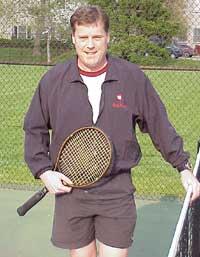The Serve and
Tennis Science
Brian Gordon, PhD
In 1992, after 10 years as a working teaching pro, I decided to try to learn more about the great game of tennis. When reading the popular literature about the game I would often note references to things like "forces" and "torques."
Even though I had no idea what the authors were talking about, I decided they must be important. My desire was to learn more about tennis, how to teach it, and how science could benefit real tennis players. And so I transited into the world of the academic study of tennis.
 |
| The result of the mathematical combination of nine NCAA Division I players can be displayed in a computer graphic |
Now 10 years later, as I finish up my PhD, I still have no idea what many of the same authors are talking about. The problem is no longer that I don't understand the technical meaning of terms like "forces" and "torques." The problem is that the use of such terms was and continues to be so misguided.
Unfortunately, reading the scientific journals is just as frustrating. It seems I usually need every bit of my eleven years of graduate education just to understand the title, not to mention the body of an article which probably does contain informative research on tennis strokes.
Most of what players and coaches know about tennis stroke technique is based on interpretation of observations made by esteemed coaches, what is called qualitative analysis. Sport biomechanists have been acquiring and analyzing data, and making quantitative measurements in many sports for decades, including tennis. The problem is that the results have not been user friendly, nor have they generally been easily accessible to practitioners of the game.
I believe there is an uncrossed bridge between the qualitative insight of coaches and the quantitative results of scientists. While some modest efforts have been made to cross the bridge, we will not really gain a complete understanding of the tennis strokes until the scientific and coaching communities truly collaborate.
This article makes a foray across that bridge, based on my quantitative study of the service motion. First I want to explain what the study found about 3 key points in the service motion. Then I want to relate it to some of the qualitative study that has appeared on Tennisplayer.net, specifically the analysis of Advanced Tennis high speed video done by John Yandell.




